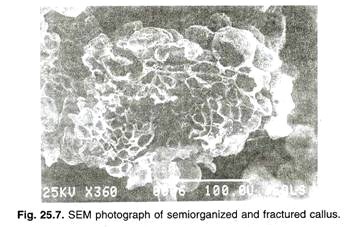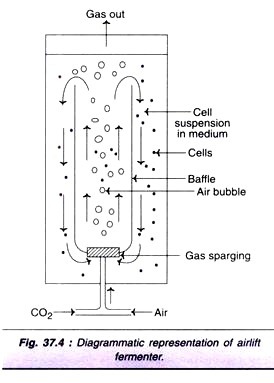Let us make an in-depth study of the biological oxidation. After reading this article you will learn about: 1. Electron Transport Chain and 2. Chemical Warfare.
This article gives the answer to the question as to “How do the food we take in and the oxygen we respire, produce energy to continue the process of life”. The simplest answer is that the food we take in is oxidized by the enzymes present in the body.
During this process some reducing equivalents viz. NADH and FADH2 are produced which are electron rich in nature. These reducing equivalents donate their electrons to the oxygen we respire in, during which energy is released to produce adenosine triphosphate (ATP). ATP is known as the energy currency of the cell and it brings about the biological process of life. In order to understand the above process, we need to understand some basic terminologies.
Oxidation and reduction can be defined in three different ways as under:
i. Oxidation is ‘Addition of oxygen’ or ‘removal of hydrogen’ or ‘removal of electrons’.
ii. Reduction is ‘Removal of oxygen’ or ‘addition of hydrogen’ or ‘addition of electrons’.
Oxidizing agent or oxidant:
An electron acceptor is an oxidizing agent or oxidant.
Reducing agent or reductant:
An electron donor is a reducing agent or reductant.
Redox potential (E0):
The relative tendency of reductant to donate electrons as compared to hydrogen is termed as oxidation-reduction potential or ‘redox potential’ (E0).
The redox potential of hydrogen is taken as zero at pH 0 (-0.417), 25° C, in a solution of 1 molar concentration (1.0 atom of hydrogen).
i. A compound having a negative value of E0 is a better electron donor than hydrogen.
ii. A compound having a positive value of E0 is a poor electron donor than hydrogen.
The electrons flow from compounds with negative value of redox potential to those with positive values of redox potential, because there will be loss of energy and thus, the compound becomes stable.
Free energy (F0):
Every chemical substance has a certain amount of energy built into it, which is the energy of the chemical bonds holding the atoms together. This is the free energy.
High energy compounds and energy rich bond (~):
Any bond, which on hydrolysis gives a minimum free energy of 7.4 Kcal/mol, is known as energy rich bond and the compound which has an energy rich bond is known as high energy compound. Ex. ATP, pyrophosphate, 1, 3-diphosphoglyceric acid, phosphoenol pyruvate, creatine phosphate and acetyl-CoA.
Adenosine triphosphate (ATP):
ATP is also known as the ‘energy currency’ of the living cell, because it transfers energy from energy yielding sources to the energy requiring cell processes. ATP has two pyrophosphate bonds. On hydrolysis of each of the terminal two phosphate groups there is release of more than 7.4 Kcal/mol of energy but the third bond yields only 3 Kcal/mol of energy, hence it is not a high energy bond. On hydrolysis ATP is converted to ADP and to AMP.
Biological oxidation:
Biological oxidation is catalysed by enzymes which function in combination with coenzymes and/or electron carrier proteins.
Different enzymes associated with biological oxidation are:
1. Oxidoreductases:
These enzymes catalyse the removal of hydrogen from the substrate and add it to another substance, thus bringing about oxidation reduction reaction. Ex. Glyceraldehyde—3— Phosphate dehydrogenase.
2. Oxidases:
These enzymes catalyse the removal of hydrogen from the substrate and add directly to the molecular oxygen. Ex. Cytochrome oxidases, tyrosinase, uricase.
3. Oxygenases:
These enzymes incorporate oxygen into the substrates.
(a) Mono-oxygenases:
Adds only one atom of oxygen to the substrate. These are also known as mixed function oxidases.
(b) Di-oxygenases:
Adds both the atoms of oxygen to the substrate. Ex. Homogentisic acid di-oxygenase.
4. Aerobic dehydrogenases:
These enzymes remove hydrogen from the substrate and add it either directly to oxygen or any other artificial acceptors like methylene blue. The product formed is hydrogen peroxide.
5. Anaerobic dehydrogenases:
These enzymes use other substrates or substances to donate the hydrogen. They transfer hydrogen’s to some other hydrogen acceptor, but not directly to oxygen. Thus the hydrogen acceptors are NAD, FAD and FMN. Heme proteins like cytochromes also receive hydrogen’s. The cytochromes are ‘b’, ‘c1‘, ‘c’, ‘a’ and ‘a3‘.
6. Hydro peroxidases:
These enzymes have either hydrogen peroxide (H2O2) or organic peroxide as their substrate.
There are two types of hydro peroxidases:
(1) Peroxidase and
(2) Catalase.
Their prime function is destruction of H2O2.
Electron Transport Chain:
When electrons are transferred from the most electronegative system [(NADH or FADH2) (-0.32V)] to the most electropositive system (+0.82V) (Oxygen), there will be liberation of all the energy at one time in an explosive manner. But, if they are transferred in a step wise manner through some intermediate systems then there will be slow release of energy and it can be captured by the cell to synthesize energy rich compounds. During biological oxidation, electrons are transferred through electron transport proteins which are arranged in a specific chain to form the electron transport chain (ETC), which is situated in the inner mitochondrial membrane.
Respiratory Chain or ETC:
Transfer of electrons from substrate to molecular oxygen through a chain of electron carriers is called electron transport chain or respiratory chain. Mitochondria contains a series of catalysts forming the respiratory chain which are involved in the transfer of electrons and hydrogen and their final reaction is with oxygen to form water. The components of respiratory chain are arranged sequentially in the order of increasing redox potential.
Electrons flow through the chain in a stepwise manner from lower redox potential to higher redox potential. Some amount of energy is liberated with transfer of electron from one component to another. Whenever there is a release of 7.4 Kcal of energy or a little more, then ATP formation takes place there. NADH forms 3 ATPs whereas FADH2 forms only 2 as it enters ETC at the site beyond the first site of ATP formation.
The/three sites of ATP formation in the ETC or respiratory chain are:
1. Between NADH dehydrogenase (flavoprotein) and ubiquinone (coenzyme Q).
2. Between cytochrome-b and cytochrome-c1.
3. Between cytochrome-a and cytochrome-a3 (cytochromes oxidase).
The components of ETC, their redox potential and their sequence is:
Phosphorylation:
Esterification of a phosphate through a high energy bond (7.4 Kcal) is known as phosphorylation. Combination of inorganic phosphate (Pi) with any other compound through high energy bond is known as phosphorylation. Or formation of ATP from ADP and phosphate or NTP from NDP and Pi is known as phosphorylation.
There are two types of phosphorylation:
1. Substrate level phosphorylation:
Formation of high energy phosphate bond at the level of a substrate without the involvement of the respiratory chain is known as substrate level phosphorylation. Ex. Phosphoenolpyruvate is converted to pyruvate by pyruvate kinase where ATP is formed from ADP.
2. Oxidative phosphorylation:
The enzymatic phosphorylation of ADP to ATP coupled with electron transport from a substrate to molecular oxygen is known as oxidative phosphorylation or respiratory chain phosphorylation.
Mechanism of Oxidative Phosphorylation:
There are three theories or hypothesis, explaining the formation of ATP through electron transport chain.
They are as follows:
1. Chemical coupling hypothesis:
It states that a high energy compound is formed taking the energy liberated by electron transfer and this compound in turn phosphorylates ADP to ATP.
2. Conformational coupling hypothesis:
There are many proteins in the wall of inner mitochondrial membrane; one of them is F0F1, ATPase, which is responsible for the ATP production. According to this hypothesis the energy liberated from ETC brings a conformational change in the proteins of the membrane and is then transferred to FQF1ATPase which thereby also gets a conformation change and hence becomes unstable. In order to attain stability it provides energy for ATP synthesis.
3. Chemiosmotic hypothesis:
It states that electron transport pumps H+ from the mitochondrial matrix across the inner mitochondrial membrane to the outer aqueous phase, thereby the matrix becomes basic and the outer phase becomes acidic. Due to this osmotic difference (i.e. more acidic outside and more basic inside the mitochondrial matrix) the H influx (diffuse) into the matrix through a pore in the F0F1 ATPase which provides the energy for the ATP synthesis.
P/O Ratio:
The number of inorganic phosphates esterified per atom of oxygen consumed is known as P/O ratio. For NADH it is 3 and FADH, it is 2.
Formation and Detoxification of H2O2:
During ETC, O2 accepts four electrons forming two H2O. If by chance O2 accepts only two electrons, the product formed is H2O2 and if it accepts only one electron then superoxide radical (:O2~) is formed. Both these damage the membrane structure by attacking the unsaturated fatty acids of the membranes.
Superoxide is detoxified as—
2O–2 + 2H + — SUPEROXIDE DISMUTASE → H2O2 + O2
H2O2 is detoxified as—
2H2O2 — CATALASE → 2H2O + O2
Cytochrome-a3:
Cytochrome-a3 is also known as cytochrome oxidase. It has two molecules of heme with long hydrocarbon side chains. To the other end of the heme, two copper atoms are attached which can directly react with oxygen to donate four electrons.
Inhibitors of ETC:
Inhibitors of ETC are those which inhibit or stop the flow of electrons in the electron transport chain.
Some of the inhibitors of ETC are:
(a) At the first site of ATP formation, rotenone and barbital inhibit the flow of electrons
(b) At the second site antimycin-A and amytal inhibits the flow of electrons.
(c) At the third site cyanide (Cn–), carbon monoxide (CO) and H2S gas inhibit.
Un-couplers of Oxidative Phosphorylation:
Un-couplers are those substances which prevent oxidative phosphorylation (formation of ATP) though ETC is normally operating. Due to the effect of un-couplers there is a continuous flow of electrons but there is no formation of ATP i.e. ETC is not coupled to the ATP formation, so the energy is dissipated as heat.
Some of the un-couplers are:
1. 2, 4-Dinitrophenol (DNP):
It transfers protons across the mitochondrial membrane thereby diverting its flow from F0F1 ATPase.
2. Valinomycin:
It transfers K4 ions, disturbing the osmotic pressure.
3. Gramicidin:
It transfers Na+ ions, across the membrane.
All the above three are known as ‘ionophores’ i.e. those which disrupt the membrane permeability to ions, thereby uncoupling phosphorylation with ETC.
4. Oligomycin:
It inhibits F0F1ATPase.
5. Atractyloside:
It inhibits adenine nucleotide transport protein of the mitochondrial membrane which transport ATP in exchange of ADP.
Some of the Mechanisms/Applications of Un-couplers are:
1. The mechanism by which body heat is increased during fever is by uncoupling.
2. Increase in the heat of the penis during erection is due to uncoupling.
3. Reduction in fat (weight) of obese persons is by the mechanism of uncoupling (banned).
4. Newly born infants have special type of mitochondria called brown fat mitochondria which are highly porous containing more cytochromes. They help in release of more heat by uncoupling, thus helping in maintaining the body temperature in the infants as they do not have sub-cutaneous fat resulting in loss of more heat.
Chemical Warfare:
It involves using the toxic properties of chemical substances to kill, injure or incapacitate an enemy. The offensive use of living organisms (such as anthrax) is considered to be biological warfare rather than chemical warfare; the use of non-living toxic products produced by living organisms, ex. toxins such as botulinum toxin, ricin, or saxitoxin is considered as chemical warfare. Chemical used in warfare is called a ‘chemical warfare agent (CWA)’.
About 70 different chemicals have been used or stockpiled as chemical warfare agents during the 20th and 21st century. These agents may be in liquid, gas or solid form. Liquid agents are generally designed to evaporate quickly; such liquids are said to be volatile or have a high vapor pressure. Many chemical agents are made volatile so that they can be dispersed over a large region quickly.
Chemical warfare agents are divided into lethal and incapacitating categories. A substance is classified as incapacitating if less than 1/100 of the lethal dose causes incapacitation, ex. through nausea or visual problems.
Classes:
Chemical warfare agents are organized into several categories according to the manner in which they affect the human body.
The names and number of categories vary slightly from source to source, but in general, different types of chemical warfare agents are-



